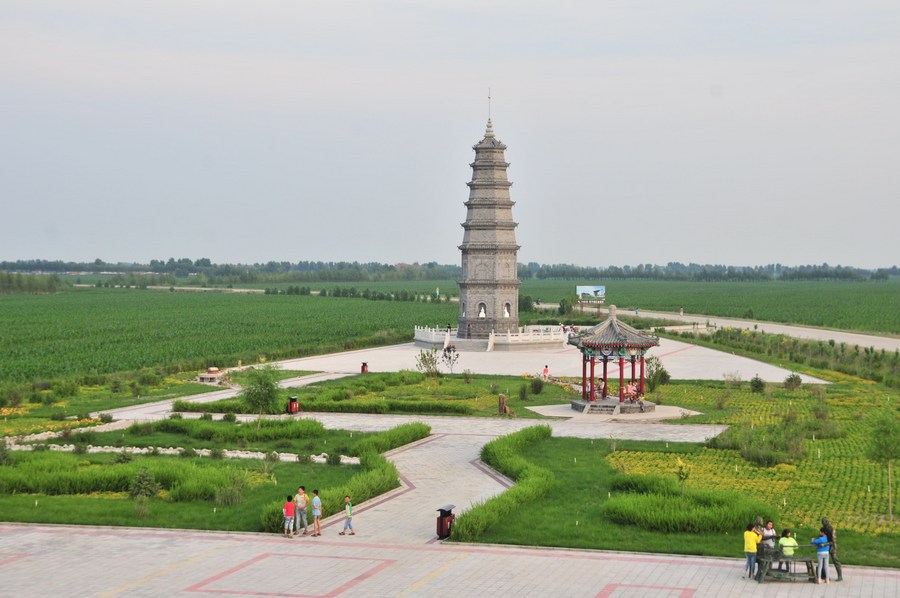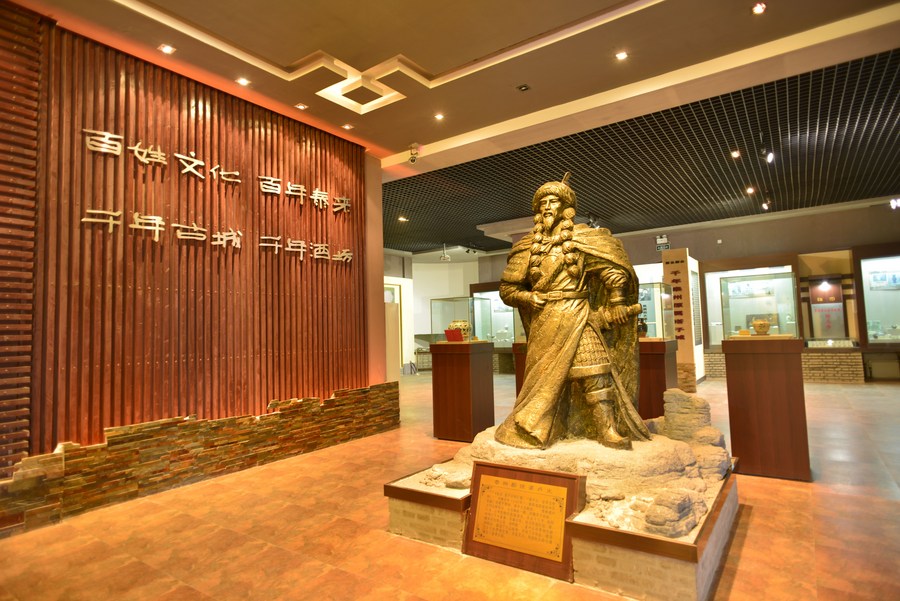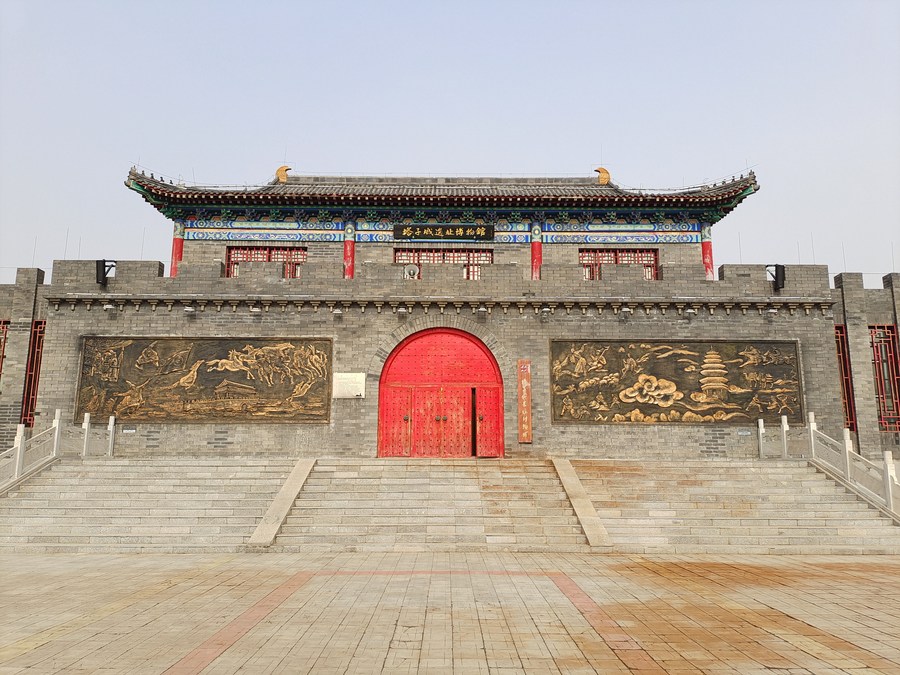NE China restores past glory of ancient city through protection, tourism

This undated photo shows a part of a square featuring cultures of the Liao Dynasty (907-1125) and the Jin Dynasty (1115-1234) in Tailai County, northeast China's Heilongjiang Province. (Xinhua)
HARBIN, June 13 (Xinhua) -- Tailai County in northeast China's Heilongjiang Province has been striving to restore the ancient glory of an over 1,000-year-old city ruins amid intensified cultural protection efforts and a boom in local tourism.
While walking along the streets in Tazicheng Township, Tailai County, one would certainly stumble upon a remarkable sight: Enclosed by towering city walls, there lies a well-preserved square-shaped ancient city site. Measuring three to six meters in height, the existing walls are remnants of the legendary border city called "Tazicheng" in Chinese.
Moated by two rivers, the ancient city was once where the administration headquarters of Taizhou in the Liao Dynasty (907-1125) was located, said Liu Xiaoliang, deputy Party secretary of today's Tazicheng Township. Historical documents indicate that many prestigious figures, such as the founding emperor Yelü Dashi of the Western Liao regime and the general who led the construction of the Great Wall of the Jin Dynasty (1115-1234), had ruled the fortress city in ancient times.
As the headquarters of the Jin Great Wall back then, the Tazicheng site is of significant academic and research value.

This undated photo shows the bronze sculpture of a general of the Jin Dynasty (1115-1234), in Tailai County, northeast China's Heilongjiang Province. (Xinhua)
"As the core of the defense system of the Jin Great Wall's northeastern section, the site offers abundant physical evidence for study on the Jin Great Wall, in terms of its construction techniques, urban planning and defensive design," said Wang Xiaoyang, head of the county's culture, sports, broadcast and television, and tourism bureau.
The site also provides plenty of materials for research on political and economic relations between the dynasties in the Central Plains and the ethnic groups in the north, Wang added.
Tailai County has set up fences and patrol roads along the ancient city walls, prohibiting cattle and sheep grazing in the city wall range to protect the site.
The local government also hosts cultural relic exhibitions and research and study activities themed on the ancient city, creating more awareness about the city's past while drawing an increasing number of tourists.
Outside the Tazicheng site stands the Tazicheng site museum. Built in 2013, the museum displays artifacts from the Liao and Jin dynasties, including iron plows, arrowheads and field caldrons, offering visitors a glimpse of the ancient battlefields.

This photo taken on March 10, 2023 shows the Tazicheng relic site museum in Tailai County, northeast China's Heilongjiang Province. (Xinhua/Chen Cong)
Yang Junhua, a teacher from the Tazicheng Central School, often takes her students to the museum for research and study activities.
"I take great pleasure in sharing stories with the students, tales that depict the history and cultural heritage of Tazicheng. I hope this can help deepen their understanding of their hometown's rich past and foster a genuine affection for the place that will inspire them to return to Tazicheng in the future and contribute to the betterment of their beloved hometown," the teacher explained.
"Since the launch of the museum, Tazicheng Township has witnessed around 20,000 visitors every year," said Bao Yuxi, head of the township.
The museum is merely a microcosm of the local culture protection efforts in recent years. According to Bao, the township also plans to form a "half-hour economic circle" in the near future by developing surrounding short-distance travel routes and holding relevant cultural performances, thereby creating a new development path of "tourism-led cultural protection."
"In August, we will host a 'Nabo Conference,' which is likely to focus on cultural and entertainment activities featuring Liao and Jin culture elements," said Bao. "Nabo" refers to a series of activities related to the nomadic customs of the Khitan people such as moving their camps and cowboy mounted shooting. The nomadic Khitan founded the Liao Dynasty.
"Facilities resembling the ancient army camps and drill grounds will also be set up, allowing tourists to experience the signature local cultures of Tazicheng," the official added.
Related articles
-
 Head of the Shanghai Ballet shares her happiness
Head of the Shanghai Ballet shares her happinessMore
-
 Panda-monium sweeps China
Panda-monium sweeps ChinaMore
-
 World's first Zootopia land opens at Shanghai Disney Resort
World's first Zootopia land opens at Shanghai Disney ResortMore
-
 Jiangxi deputy: Preserving historic figures' residences helps reinforce a city's identity
Jiangxi deputy: Preserving historic figures' residences helps reinforce a city's identityMore
-
 China's FAST telescope detects binary pulsar with orbital period of 53.3 minutes
China's FAST telescope detects binary pulsar with orbital period of 53.3 minutesMore
-
 Counting down to Chengdu Universiade: venues with "Sichuan flavor"
Counting down to Chengdu Universiade: venues with "Sichuan flavor"More
